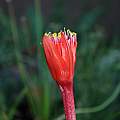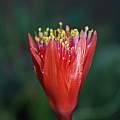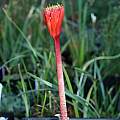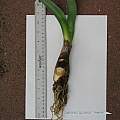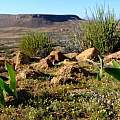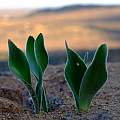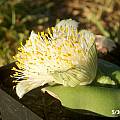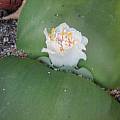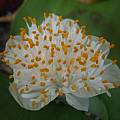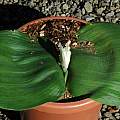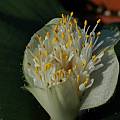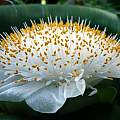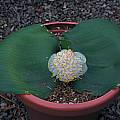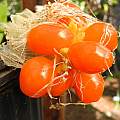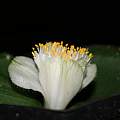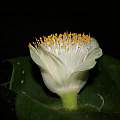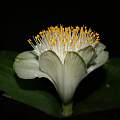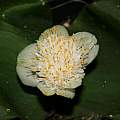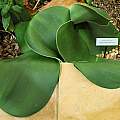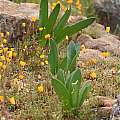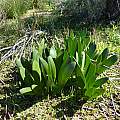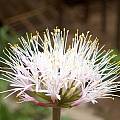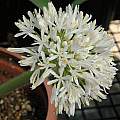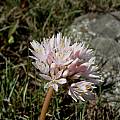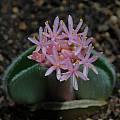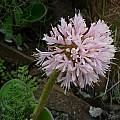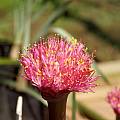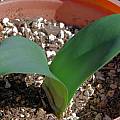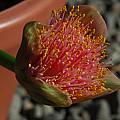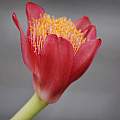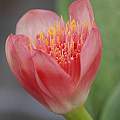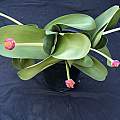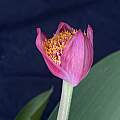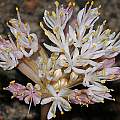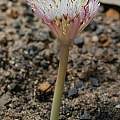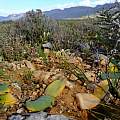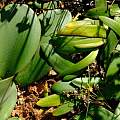Haemanthus is a genus in the Amaryllidaceae family confined to South Africa and Namibia. The 22 currently known species are characteristically fleshy, often hairy plants, well known for their compact, brush-like inflorescences. Their specialized fruits are berries which contain a few large, moisture-rich seeds. Species are found both in winter and summer rainfall regions. A revision of this genus was written by Deirdre Snijman in 1984. Haemanthus species d-l are found on this wiki page.
Haemanthus a-c - Haemanthus m-z
Haemanthus dasyphyllus Snijman is native to Langberg and Kubiskouberg, north west of Loriesfontein and is found in localized populations. The leaves are light green, lanceolate with a covering of long soft white hairs on both surfaces, the abaxial surface or the edges only. The leaf blades are erect, usually twisted and speckled with red at the base. The first four photos below were taken by Nhu Nguyen. The last two photos from iNaturalist of the leaves taken by Nick Helme and shared under a CC BY-SA license. He wrote that it is common on granite domes in patches of soil.
Haemanthus deformis Hook.f. is an evergreen plant found in shade and on moist rocky banks in the KwaZulu-Natal. It has thick, flat, leaves that persist for over a year. New leaves appear after the white flowers and as the old leaves start to turn brown. Flowering time is May to October in habitat in the Southern Hemisphere. The first photo was taken by Cameron McMaster. The next two are of a Margate form from Uluwehi Knecht.
Photos from Mary Sue Ittner show various stages of flowering.
Photos 1-4 below were taken by Nhu Nguyen. The last photo from Mary Sue Ittner shows the leaves of the plant displayed in the bulb room at Kirstenbosch National Botanical Garden.
Haemanthus graniticus Snijman is a Namaqualand species found in coarse and granitic soils along seasonal watercourses in mountain renosterveld. This species has 2 to 3 erect lanceolate glabrous green leaves appearing after the inflorescence. The flowering stem is red, smooth, and unmarked and the flowers and spathe valves are various shades of red. This species flowers in the fall. Photo 1 taken by Andrew Harvie in the Kamiesberg. Photo 2 taken September 2011 by Cameron McMaster.
Haemanthus humilis Jacq. see the Haemanthus humilis page.
Representative photos of this species from Cameron McMaster and Mary Sue Ittner.
Haemanthus hybrid 1 Seed was received from Doug Westfall labeled Haemanthus albiflos. One seemed different and is probably a hybrid. It has two leaves that in the beginning were evergreen, but the last two years have been deciduous during the summer and appear with the bud in the fall. It has pink flowers. Photos by Mary Sue Ittner.
Haemanthus hybrid 2 is a cross between Haemanthus albiflos × Haemanthus coccineus sometimes referred to as Haemantus × clarkei and some have flowered, showing different shades of red-pink. All the plants are evergreen, growing in the same way as the H. albiflos parent. Photos Angelo Porcelli.
Haemanthus hybrid 3 Purchased by Richard Sullivan unnamed from a grower in southern California this may be what is circulating as Haemanthus × clarkei. It is shown here filling a 5 gallon container. It remains evergreen through the year with leaves lasting for many seasons. I have pollinated it with pollen from Haemanthus coccineus and a few seeds have formed - see third photo.
Haemanthus lanceifolius Jacq. grows in a low rainfall and low elevation area of Namaqualand where it is found in sandy or stony alkaline soils. Leaves are adpressed to the ground, oblong to elliptical and the flowers are small, white or pink with well-exserted stamens. The first two photos from Andrew Harvie. The last two photos of the leaves from iNaturalist were taken by Nick Helme and shared under a CC BY-SA license. He wrote: "loamy soils over marble, on flatter slopes; rare local endemic; threatened by cultivation and new marble mine opening up; lvs with reddish cilia on edges (a bit like Crossyne guttata).
Haemanthus index - Haemanthus a-c - Haemanthus m-z
